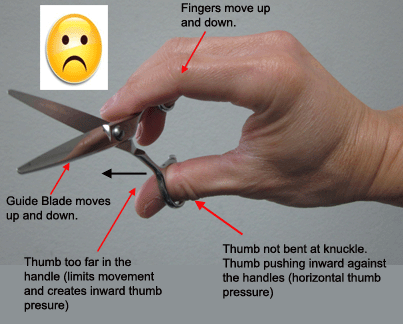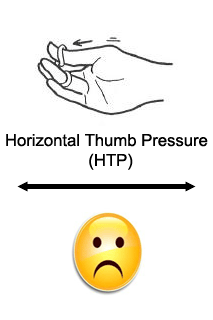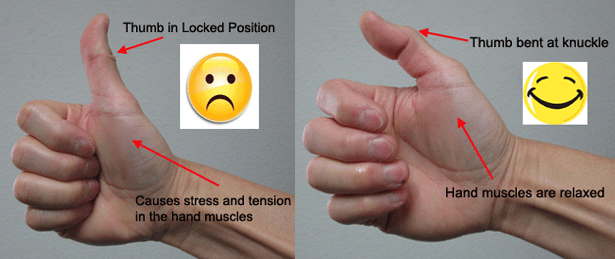

Horizontal Thumb Pressure is one of the leading causes of:
- Fatigue and pain in the fingers, hands, wrists, and arms
- Dull and nicked scissor blades
What is Horizontal Thumb Pressure?
Horizontal Thumb Pressure (HTP) is the force created by a stylist pressing their thumb against, inward towards, or through the thumb hole of the handle of their scissors as they cut hair. While a scissor may tolerate a negligible amount of thumb pressure, the majority of stylists exert far more horizontal pressure than is advisable, unknowingly damaging their scissors and stressing their hand in the process. Sadly, HTP can quickly develop into an unconscious habit that causes numerous problem.


How is Horizontal Thumb Pressure harmful to scissors and stylists?
While a scissor can tolerate a negligible amount of thumb pressure, many stylists exert more horizontal pressure than is necessary. This can add stress to the hands and cause damage to the scissors.
Horizontal Thumb Pressure significantly impairs the performance of high quality scissors by grinding the inside edges of the blades as they open and close.This metal-on-metal friction erodes the cutting edges, dulls the blades, and causes nicks. The performance of the scissors can swiftly deteriorate and the premature dulling may be noticeable within days or weeks. Premature dulling can cause stylists to exert even more thumb pressure, and soon Horizontal Thumb Pressure becomes a chronic habit.
More importantly, Horizontal Thumb Pressure can cause stress on a stylist's fingers, hand, and wrist. This can lead to hand fatigue, pain, cramping, and over time, ailments such as repetitive motion syndrome (rms), carpal tunnel syndrome (cts), and tennis elbow.
What is Vertical Thumb Movement Only (VTMO)?


VTMO is using a relaxed thumb to move the scissor handle in an up and down (vertical) direction only; zero horizontal thumb pressure is applied. This technique allows the scissors' pivot area and blade sharpness to generate the perfect amount of power to precisely and effortlessly cut. The scissor handle with the finger hole (known as the guide blade) never moves. It serves as a stable base for fingers that are relaxed and in control, optimizing radial freedom but not interfering with the scissors' functions.
In contrast to HTP, VTMO is beneficial for both the stylist and the scissor. It is ergonomically optimal, maximizes cutting precision and consistency, and minimizes hand stress and scissor wear.
VTMO is a cornerstone of the Hikari scissor design. Accordingly, Hikari scissors perform their best when the thumb moves in an up or down direction only. Any nonvertical movement, force, or thumb pressure, especially HTP, works againste the scissors and will result in dull or nicked blades.
Please read the section below titled Use Vertical Thumb Movement Only (VTMO) Techniques for additional important information on how to effectively use Hikari scissors.

In order to analyze your own cutting style and successfully implement safeguards against HTP, please read the following important information.
Problem: A Locked Thumb Leads to HTP
Many stylists lock their thumbs while they cut. The drawbacks of a locked thumb can be demonstrated by pointing your thumb as if you were a hitchhiker soliciting a ride. As you extend and lock your thumb, note how the muscles in the palm engage. All the muscles in the hand are firm and taut because a locked thumb cannot relax and is prone to applying HTP. In contrast, notice that when you bend your thumb, the fingers, hand, wrist, and arm all relax.

Solution: Use Vertical Thumb Movement Only (VTMO™) Techniques
Cutting with VTMO™ entails having a relaxed thumb, slightly bent at the knuckle, and resting only the tip of the thumb in the thumb hole of the scissor handle. As the thumb moves vertically, the scissor handle moves up and down. The scissor handle with the finger hole (known as the guide blade) never moves. The thumb movement puts only one of the handles in motion. This technique allows the pressure generated from the pivot design and the sharpness of the blades to do all of the work.
Practice these five steps to cut with VTMO™:
1. Keep your thumb knuckle slightly bent at all times. This enables your hand and wrist to relax and minimizes the tendency to apply thumb pressure.
2. Insert only the tip of your thumb into the thumb hole. This will maximize your range of motion and protect you from applying HTP. To guard against inserting your thumb too far through the hole, it may be helpful to put a finger ring in the thumb hole.
3. Using the tip of your thumb, while bending the knuckle, move the scissor handle in an up and down direction only. Be careful not to push or press the handle in any other directions or angles.
4. Ensure the guide blade (the scissor handle with the finger hole) does not move up or down; it should be completely still. A motionless guide blade serves as a stable base for your fingers to rest upon; prevents HTP; and enables you to cut a precise, straight line.
5. Let your hand relax into a natural position, supported by the contours of the handle. Refrain from gripping, pushing, pulling, or pressing the scissor with force as this will restrict your freedom of movement and inhibit the natural cutting stroke.
Problem: Incorrect Tension Results in Grinding
Over time, the tension screw and washer in the pivot area of scissors may loosen and settle. If the tension screw is not promptly adjusted, the scissor blades may become misaligned or unbalanced, drastically harming the scissors’ performance. If the blades fail to meet at the proper angle or the pivot function is impaired, the scissors may bend, fold, or push hair instead of cutting it, and the precision of the cut will be diminished. Furthermore, HTP will be required to cut when using scissors with loose tension.
Solution: Check the Tension Daily
A quick solution to avoid cutting with loose tension is to check a scissors’ tension on a daily basis and adjust the tension screw as appropriate. Checking and adjusting the tension can be completed in less than one minute and is essential to maintaining the scissors’ performance and sharpness. (Click here for information on how to check your scissors tension).
Solution: Oil Daily
Another simple preventative measure is to oil your scissors daily. Hikari oil is a protective lubricant that fights rust and corrosion and helps the blades glide as they flex across each other when cutting. Scissors that are not regularly oiled will dull quicker due to the friction between the blades. (Click here for detailed instructions how to properly oil your scissor).
Problem: Muscle Memory Never Forgets Dull Scissors
Frequently, stylists “temporarily” use dull scissors in an attempt to defer the expense and inconvenience of scissor sharpening. Unfortunately, dull scissors require increased thumb pressure to cut, and even brief experiences applying HTP are immediately incorporated into the hand’s muscle memory. When dull scissors are eventually sharpened, the thumb’s muscle memory continues to apply the same excessive pressure used when the scissors were dull. As a result, the newly sharpened scissors very quickly become dull, and the HTP cycle repeats itself.
Solution: Utilize a Quality Backup Scissor
Since even intermittently applying HTP can quickly become a dominant, stubborn habit, at the first signs your primary scissors are dulling or require service, immediately switch to using your backup scissors. A quality, sharp, backup pair of scissors is a must-have for all stylists, not only to address unforeseen circumstances, but to protect you from acquiring the HTP habit. An investment in a quality backup scissor is far less than the continuing expense of addressing the many problems caused by HTP.
Problem: Higher Blade Angle (and Non-Hikari) Scissors Require HTP
Lesser quality scissors usually require HTP to cut because they lack the sharpness and balance to cut without it. Similarly, non-Hikari sharpened scissors have higher blade angles that require HTP to cut. Only Hikari scissors serviced by Hikari have low blade angles designed to cut with VTMO™. Moreover, a Hikari scissor serviced by anyone other than Hikari will probably require HTP to cut because non-Hikari sharpeners do not have the specialized training required to properly service or maintain the Hikari low blade angle.
Solution: Adjust to Higher Quality Scissors
When switching or upgrading to a Hikari or a Hikari serviced scissor, stylists must make a deliberate effort to relax their thumb and refrain from exerting HTP. If a stylist continues to use the same substantial thumb pressure required on a lower quality scissor, then like any high quality scissor subjected to HTP, Hikari scissors will rapidly become dull.
In summary, VTMO™ is an effortless, precise cutting technique, and scissors that induce or require HTP should be avoided. Only Hikari offers true VTMO™-designed scissors that enable stylists to reap the many benefits of VTMO™.
Questions?
If you would like more information on keeping your scissors in top working condition, please see the care and maintenance section of our website. Also on this page is a care and maintenance video.
As the only scissor company founded and managed by hairdressers, Hikari is passionate about the hair industry and hair stylists! Our goal is to provide you with the tools and knowledge for an enjoyable and productive career. If you have any questions regarding care, maintenance, and thumb pressure, please call us at 1-310-516-0350.